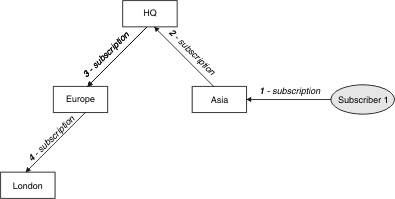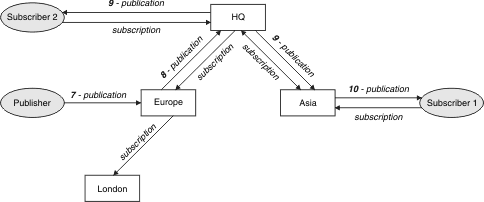Routing in publish/subscribe hierarchies
If your distributed queue manager topology is a publish/subscribe hierarchy, and a subscription is made on a queue manager, by default a proxy subscription is created on every queue manager in the hierarchy. Publications received on any queue manager are then routed through the hierarchy to each queue manager that hosts a matching subscription.
For an introduction to how messages are routed between queue managers in publish/subscribe hierarchies and clusters, see Distributed publish/subscribe networks.
When a subscription to a topic is made on a queue manager in a distributed publish/subscribe hierarchy, the queue manager manages the process by which the subscription is propagated to connected queue managers. Proxy subscriptions flow to all queue managers in the network. A proxy subscription gives a queue manager the information it needs to forward a publication to those queue managers that host subscriptions for that topic. Each queue manager in a publish/subscribe hierarchy is only aware of its direct relations. Publications put to one queue manager are sent, through its direct relations, to those queue managers with subscriptions. This is illustrated in the following figure, in which Subscriber 1 registers a subscription for a particular topic on the Asia queue manager (1). Proxy subscriptions for this subscription on the Asia queue manager are forwarded to all other queue managers in the network (2,3,4).

A queue manager consolidates all the subscriptions that are created on it, whether from local applications or from remote queue managers. It creates proxy subscriptions for the topics of the subscriptions with its neighbors, unless a proxy subscription already exists. This is illustrated in the following figure, in which Subscriber 2 registers a subscription, to the same topic as in Figure 1, on the HQ queue manager (5). The subscription for this topic is forwarded to the Asia queue manager, so that it is aware that subscriptions exist elsewhere on the network (6). The subscription is not forwarded to the Europe queue manager, because a subscription for this topic has already been registered; see step 3 in Figure 1.

When an application publishes information to a topic, by default the receiving queue manager forwards it to all queue managers that have valid subscriptions to the topic. It might forward it through one or more intermediate queue managers. This is illustrated in the following figure, in which a publisher sends a publication, on the same topic as in Figure 2, to the Europe queue manager (7). A subscription for this topic exists from HQ to Europe, so the publication is forwarded to the HQ queue manager (8). However, no subscription exists from London to Europe (only from Europe to London ), so the publication is not forwarded to the London queue manager. The HQ queue manager sends the publication directly to Subscriber 2 and to the Asia queue manager (9). The publication is forwarded to Subscriber 1 from Asia (10).

Summary and additional considerations
A publish/subscribe hierarchy gives you precise control over the relationship between queue managers. After it has been created, it needs little manual intervention to administer. However it also imposes certain constraints upon your system:- The higher nodes in the hierarchy, especially the root node, must be hosted on robust, highly available, and performant equipment. This is because more publication traffic is expected to flow through these nodes.
- The availability of every non-leaf queue manager in the hierarchy affects the ability of the network to flow messages from publishers to subscribers on other queue managers.
- By default, all topic strings subscribed to are propagated throughout the hierarchy, and publications are propagated only to remote queue managers that have a subscription to the associated topic. Therefore rapid changes to the set of subscriptions can become a limiting factor. We can change this default behavior, and instead have all publications propagated to all queue managers, which removes the need for proxy subscriptions. See Subscription performance in publish/subscribe networks. Note: A similar restriction also applies to direct routed clusters.
- Because of the interconnected nature of publish/subscribe queue managers, it takes time for proxy subscriptions to propagate around all nodes in the network. Remote publications do not necessarily start being subscribed to immediately, so early publications might not be sent following a subscription to a new topic string. We can remove the problems caused by the subscription delay by having all publications propagated to all queue managers, which removes the need for proxy subscriptions. See Subscription performance in publish/subscribe networks. Note: This restriction also applies to direct routed clusters.
- For a publish/subscribe hierarchy, adding or removing queue managers requires manual configuration to the hierarchy, with careful consideration to the location of those queue managers and their reliance on other queue managers. Unless you are adding or removing queue managers that are at the bottom of the hierarchy, and therefore have no further branches below them, you will also have to configure other queue managers in the hierarchy.
Before we use a publish/subscribe hierarchy as your routing mechanism, explore the alternative approaches detailed in Direct routing in publish/subscribe clusters and Topic host routing in publish/subscribe clusters.